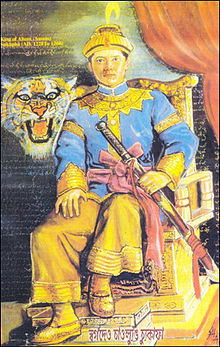| Sukaphaa | |||||
|---|---|---|---|---|---|
| Chaolung | |||||
 Fictional representation of Sukapha by Pushpa Gogoi Fictional representation of Sukapha by Pushpa Gogoi | |||||
| Ahom King | |||||
| Reign | 1228–1268 | ||||
| Predecessor | Post established | ||||
| Successor | Suteuphaa | ||||
| Born | c. 1189 Mong Mao kingdom (present day Yunan province of China) | ||||
| Died | 1268 (aged 78-79) Charaideo, Ahom kingdom (present day India) | ||||
| Burial | Sukaphaa Maidam, Charaideo | ||||
| Spouse |
| ||||
| Issue | Suteuphaa | ||||
| |||||
| House | Su/Tsu (Tiger) clan | ||||
| Dynasty | Ahom dynasty | ||||
| Father | Chao Chang-Nyeu | ||||
| Mother | Blak Kham Sen | ||||
| Religion | Ahom religion | ||||
| Ahom dynasty | ||||||||||||||||||||||||||||||||||||||||||||||||||||||||||||||||||||||||||||||||||||||||||||||||||||||||||||||||||||||||||||||||||||
|---|---|---|---|---|---|---|---|---|---|---|---|---|---|---|---|---|---|---|---|---|---|---|---|---|---|---|---|---|---|---|---|---|---|---|---|---|---|---|---|---|---|---|---|---|---|---|---|---|---|---|---|---|---|---|---|---|---|---|---|---|---|---|---|---|---|---|---|---|---|---|---|---|---|---|---|---|---|---|---|---|---|---|---|---|---|---|---|---|---|---|---|---|---|---|---|---|---|---|---|---|---|---|---|---|---|---|---|---|---|---|---|---|---|---|---|---|---|---|---|---|---|---|---|---|---|---|---|---|---|---|---|---|
 | ||||||||||||||||||||||||||||||||||||||||||||||||||||||||||||||||||||||||||||||||||||||||||||||||||||||||||||||||||||||||||||||||||||
List of Ahom kings
|
||||||||||||||||||||||||||||||||||||||||||||||||||||||||||||||||||||||||||||||||||||||||||||||||||||||||||||||||||||||||||||||||||||
Sukaphaa (r. 1228–1268), also Siu-Ka-Pha, the first Ahom king in medieval Assam, was the founder of the Ahom kingdom and the architect of Assam. A prince of the Su/Tsu (Tiger) clan of the Mao-Shan sub-tribe originally from present-day Mong Mao, Yunnan Province, China, the kingdom he established in 1228 existed for nearly six hundred years and in the process unified the various ethnic groups of the region that left a deep impact on the region. In reverence to his position in Assam's history the honorific Chaolung is generally associated with his name (Chao: lord; Lung: great).
Since 1996, December 2 has been celebrated in Assam as the Sukaphaa Divas, or Asom Divas (Assam Day), to commemorate the advent of the first king of the Ahom kingdom in Assam after his journey over the Patkai Hills.

Ancestry
Legend
According to Ahom tradition, Sukaphaa was a descendant of the god Khunlung, who had come down from the heavens and had ruled Mong-Ri-Mong-Ram. Sukaphaa brings a divine diamond chum-Phra-rung-sheng-mung in a box, a divine tusked elephant, a divine chicken Kaichengmung, a divine embroidered cloth, a divine pair of drums, a divine sword Hengdan.
Prince of Mong Mao
The details of Sukaphaa's life and origins before his entry into Assam, available from different chronicles, both Ahom and non-Ahom, are full of contradictions. According to Phukan (1992) who has tried to hold up a consistent account, Sukaphaa was born to Chao Chang-Nyeu (alias Phu-Chang-Khang) and Nang-Mong Blak-Kham-Sen in the Tai state of Mong Mao (also called Mao-Lung, with the capital at Kieng Sen), close to present-day Ruili in Yunnan, China. Chao Chang Nyeu was a prince from Mong-Ri Mong-Ram, who had travelled to Mong Mao possibly on an expedition. Mong Mao was then ruled by Chao Tai Pung. Chao Chang Nyeu was later befriended by Pao Meo Pung, the son of the ruler, who gave his sister Blak Kham Sen in marriage. Sukaphaa was born of this union not later than 1189 CE and was brought up by his maternal grandparents. Pao Meo Pung, who eventually ruled Mong Mao, had no male heir and Sukaphaa, his nephew, was nominated to succeed him. A son born late to Pao Meo Pung's queen ended Sukaphaa's claim to the throne of Mong Mao.
Departure from Mong Mao
After his 19 years as crown prince came to an end, Sukaphaa decided to leave Mong Mao.
According to tradition, his grandmother advised him thus - "no two tigers live in the same jungle, no two kings sit on the same throne." Accordingly, Sukaphaa is said to have left Chieng-Sen the capital of Mong Mao in the year 1215 CE.
Journey into Assam
Sukaphaa left Mong Mao in 1215. He was accompanied by three queens, two sons and a daughter; chiefs from five other dependent Mongs; members of the priestly class and soldiers—a total contingent of 9,000. Some commoners are recorded as having joined this core group on the way. Sukaphaa had with him 300 horses fitted with saddles and bridles and two elephants. Heavy arms were transported along a different route. Sukaphaa followed an older known route from Yunnan to Assam that passed through Myitkyina, Mogaung and the upper Irrawaddy river valley. On his way he stopped at various places and crossed the Khamjang river to reach the Nangyang lake in 1227. Here he subjugated the Nagas very ferociously and established a Mong. He left one Kan-Khrang-Mong there to guard the passage back, and proceeded to cross the Patkai hills at the Pangsau pass and reached Namrup (in the Brahmaputra valley) in December 1228. The journey, from Mong Mao to Namrup thus took Sukaphaa about thirteen years and the year he reached Namrup is considered as the year the Ahom kingdom was established.
Sukaphaa in Assam
Sukaphaa came into Assam not as a raiding conqueror but as a head of an agriculture folk in search of land. It appear he didn't encroach upon the land of peasants, rather he opened up new areas for settlement, procuring with shrewd diplomacy what he direly needed for the purpose- the service of the local inhabitants: Come and have mutual introduction with us.You are the host, the natives of this land: we are guests coming from an up-country. You should introduce to us the local people. His appeal had the desired effect and the tribes were subsequently won over. Sukaphaa moved and lived amongst the tribesman, learnt their languages, honoured their religious rites, married their daughters and led a simple life of a commoner, himself cultivating in the land. He accepted them to his social fold, placed them on equal footing with his own men and treated them as his friends.
Establishment of Ahom Kingdom
Over the next few years, he moved from place to place searching for the right capital, leaving behind his representative at each stage to rule the colonised land. Then he went up the Burhidihing river and established a province at Lakhen Telsa. Then he came back down the river and established his rule at Tipam. In 1236 he moved to Mungklang (Abhoipur), and in 1240 down the Brahmaputra to Habung (Dhemaji). In 1244 he went further down to Ligirigaon (Song-Tak), a few miles from present-day Nazira, and in 1246 to Simaluguri (Tun Nyeu), a place downstream from the present-day Simaluguri. Finally in 1253 he built himself his capital city at Charaideo near present-day Sibsagar town. The capital of the Ahom kingdom changed many times after this, but Charaideo remained the symbolic center of Ahom rule.
With the help of local recruits, he established three large farms for sali rice cultivation, called Barakhowakhat, Engerakhat and Gachikalakhat.
In 1268 Sukaphaa died. At the time of his death, his kingdom was bounded by the Brahmaputra River in the west, the Disang River in the north, the Dikhow River (26°58′15″N 94°38′12″E / 26.970732°N 94.636745°E / 26.970732; 94.636745) in the south and the Naga Hills in the east.
Even though Sukaphaa treated the people of the Patkai hills very severely on his way to the Brahmaputra valley, his approach to the population in Assam was conciliatory and non-confrontational. He married the daughters of Badaucha, the Moran Chief and Thakumatha, the Barahi chief and established cordial relations with them. As he began establishing his domain, he avoided regions that were heavily populated. He encouraged his soldiers as well as members of the Ahom elite to marry locally. A process of Ahomisation (whereby locals who adopted Ahom methods of wet rice cultivation and statecraft were accepted into the Ahom fold) bolstered the process of integration. The local Borahi and the Moran people, speakers of Tibeto-Burman languages, addressed Sukaphaa's people as "Ha-Cham", that later on developed into "Assam" or "Ahom" (see Etymology of Assam), the name of the kingdom; and "Ahom", the name of the people.

Memorial


- On 2 December, Assam celebrates the Sukaphaa Divas, or Asom Divas (Assam Day). An award is given by State Govt. that day to a prominent personality.
- Sukapha Samannay Kshetra (26°42′58″N 94°04′42″E / 26.7161399°N 94.0782113°E / 26.7161399; 94.0782113) : Inaugurated on 2 December 2015, at Mohbondha, Jorhat.
- A 100-feet long statue of Chaolung Siu Ka Pha was unveiled in Nazira, Assam on 26 February 2021 by Assam Health, Finance and Education Minister Dr. Himanta Biswa Sarma. It stirred controversy because of its "weird looking" face.
- Sukaphaa Bhawan at Khanapara, Guwahati (26°07′32″N 91°48′13″E / 26.1254446°N 91.8036044°E / 26.1254446; 91.8036044)
- Sukaphaa Bhawan at Borbaruah, Dibrugarh. (27°20′49″N 94°51′57″E / 27.346944°N 94.865833°E / 27.346944; 94.865833)
- A cruise in the name of RV Sukafa plying on Brahmaputra.
See also
Notes
- Yasmin Saikia (2004), Fragmented memories : struggling to be Tai-Ahom in India. 2004. pp. 242–3.
- Baruah (1986, p. 661)
- "...the advance of the Tais under Sukapha (Siu-Ka-Pha) was a historical fact and is well documented by records and traditions." (Phukan 1992:51)
- "The choice fell on him not only for his qualities as a military leader, but also for his privileged birth in the Chao-pha (noble-celestial) or royal clan from which alone a Tai segmentary society could customarily choose its chief. More precisely, he belonged to the Tiger (Su/Tsu) clan of the Mao-Shan sub-tribe." (Guha 1983:13)
- "...it is not until Sukapha became king in 1228 AD..." (Gait 1906:iv)
- (Phukan 1992:67) According to the Buranji by Kashinath Tamuli Phukan, Chao Tai Pung ruled Mong Mao, and had two sons, Pao Meo Pung (who finally ruled Mong Mao) and Phu Chang Khang (who finally ruled Mong Mit). Sukaphaa was born to Phu Chang Khang. This version is discounted by Phukan (1992).
- (Gogoi 1968)
- (Gogoi 1968:251)
- Most Buranjis attest to this version. Some Tai chronicles from outside Assam record the journey of Sukaphaa from Mong Mit (and not Mong Mao) in 1227 where he was the ruler (Gogoi 1968:253). According to this version, Sukaphaa's father had earlier divided his Mong among his three sons, and Sukaphaa became the ruler of Mong Mit about 1209. The immediate cause of departure was the aggression of Su-Khan-Pha of Mong Mao.
- Mong-Hkang, Mong-Hkru-Dai, Mong-Hka Mong-Pun, Mong-Phu and Mong-Li (Gogoi 1968:256–257).
- (Phukan 1992:51)
- Comprehensive history of Assam, SL Baruah. p. 222.
- (Phukan 1992:52)
- ^ (Phukan 1992:53)
- (Gogoi 2002, p. 27)
- (Gogoi 1968:264)
- (Guha 1983:12). "...the Ahoms assimilated some of the Nagas, Moran and Barahi neighbors and later also large sections of the Chutiya and the Kachari tribes. This Ahomisation process went on until the expanded Ahom society itself began to be Hinduised from the mid-16th century onwards." The Ahomization of neighbors, thus, began with Sukaphaa himself.
- "Gogoi inaugurates Sukapha Samannay Kshetra in Jorhat". Assam Tribune.
- Desk, Digital (25 February 2021). "100-foot Chaolung Siu Ka Pha statue at Nazira » News Live TV » Assam". News Live TV. Retrieved 15 April 2021.
{{cite web}}:|last=has generic name (help)
References
- Saikia, Yasmin (2004), Fragmented Memories: Struggling to be Tai-Ahom in India, Duke University Press, ISBN 9780822333739
- Gogoi, Jahnabi (2002), Agrarian System Of Medieval Assam, New Delhi: Concept Publishing Company
- Gogoi, Padmeshwar (1968), The Tai and the Tai Kingdoms, Guwahati: Gauhati University
- Guha, Amalendu (December 1983), "The Ahom Political System: An Enquiry into the State Formation Process in Medieval Assam (1228-1714)", Social Scientist, 11 (12): 3–34, doi:10.2307/3516963, JSTOR 3516963
- Phukan, J. N. (1992), "The Tai-Ahom Power in Assam", in Barpujari, H. K. (ed.), The Comprehensive History of Assam, vol. 2, Guwahati: Assam Publication Board, pp. 49–60
- Baruah, S L (1986), A Comprehensive History of Assam (book), New Delhi: Munshiram Manoharlal Publishers
- Gait, Edward A (1906), A History of Assam, Calcutta, ISBN 9780404168193
{{citation}}: CS1 maint: location missing publisher (link)
External links
- Siu-Ka-Pha – a great visionary An article by Babul Tamuli published in The Assam Tribune on the occasion of Siu-Ka-Pha Divas.
- Siukapha–an epitome of harmony An article by Dr Sikhamoni Konwar published in The Assam Tribune on the occasion of Siu-Ka-Pha/Assam Divas on 2 December 2008.